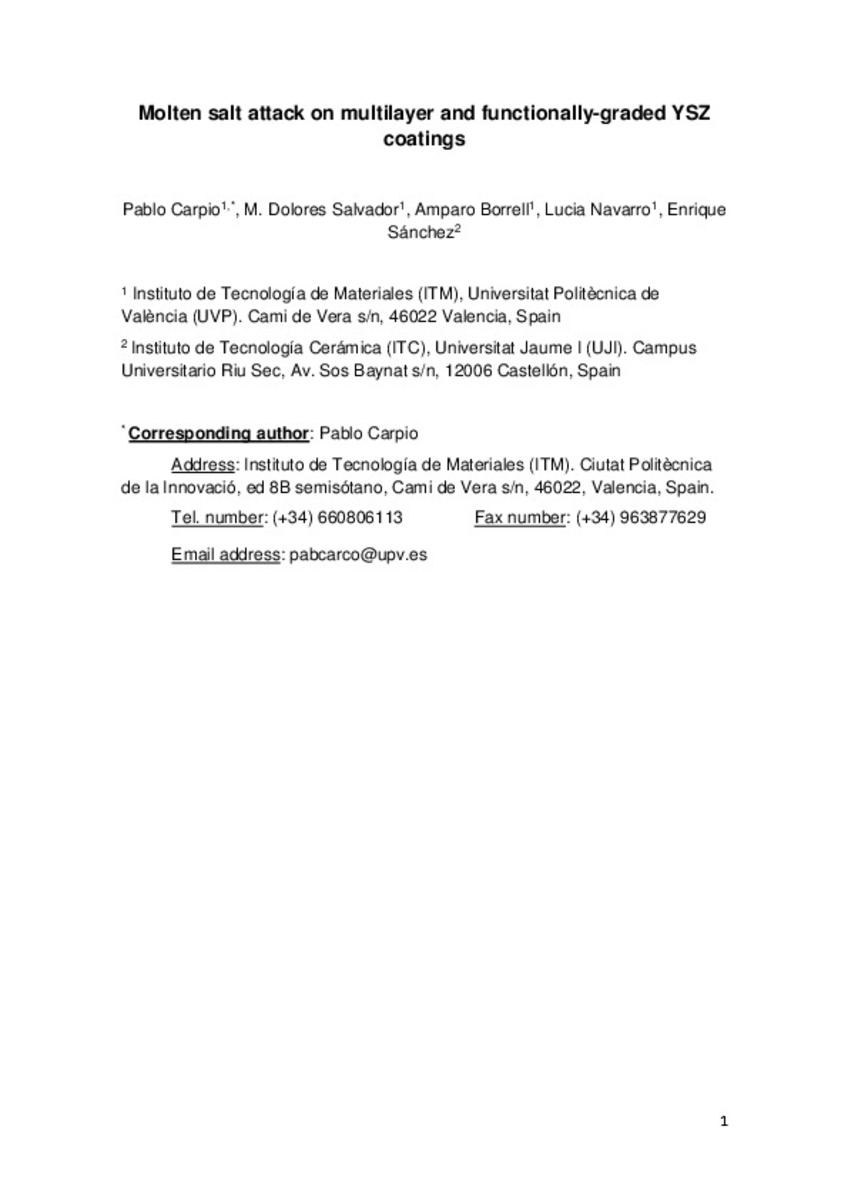Mostrar el registro sencillo del ítem
Molten salt attack on multilayer and functionally-graded YSZ coatings
| dc.contributor.author | Carpio Cobo, Pablo | |
| dc.contributor.author | Salvador Moya, María Dolores | |
| dc.contributor.author | Borrell, A. | |
| dc.contributor.author | Navarro, Lucia | |
| dc.contributor.author | Sánchez-Vilches, Enrique | |
| dc.date.accessioned | 2018-09-17T10:35:50Z | |
| dc.date.available | 2018-09-17T10:35:50Z | |
| dc.date.issued | 2018-08-01 | |
| dc.identifier.citation | CARPIO, Pablo, et al. Molten salt attack on multilayer and functionally-graded YSZ coatings. Ceramics International, 2018, vol. 44, no 11, p. 12634-12641 | ca_CA |
| dc.identifier.issn | 0272-8842 | |
| dc.identifier.issn | 1873-3956 | |
| dc.identifier.uri | http://hdl.handle.net/10234/176081 | |
| dc.description.abstract | Thermal barrier coatings have been extensively studied in the last years in order to increase the operational temperature of the current gas turbines as well as to improve the coating lifetime. Many coating characteristics must be met to achieve these requirements (low thermal conductivity, high thermal fatigue resistance…); therefore, complex systems have been engineered for these purposes. One of the possibilities to optimise the different properties deals with the design of multilayer or functionally-graded coatings where various types of microstructures with different characteristics are combined. One of the most important cause of gas turbines degradation relates to the attack of different type of particles which are suspended in the atmosphere (sand, fly ash…). These solid particles are molten at the operational temperatures and then, the molten salts chemically react with the coating. For this reason, the present research was focused on this type of attack. In the present work, the molten salt attack of various YSZ coatings with multilayer and functionally-graded design was addressed. Two different type of microstructures were specifically combined for this design: the APS coating microstructure obtained from conventional (microstructured) powder and a bimodal structure with nanozones obtained from nanostructured feedstock. Besides, different salts were used to simulate different attack environments (desert sand and volcanic fly ash). Findings show that nanozones act as barrier against the penetration of molten salts toward deeper layer. However, a layer formed by nanozones can detach when the salt attack is too aggressive. Hence, functionally-graded coatings, where two types of microstructures are combined through the whole coating, become ideal to diminish the molten salt attack. | ca_CA |
| dc.format.extent | 8 p. | ca_CA |
| dc.format.mimetype | application/pdf | ca_CA |
| dc.language.iso | eng | ca_CA |
| dc.publisher | Elsevier | ca_CA |
| dc.relation.isPartOf | Ceramics International, 2018, vol. 44, no 11 | ca_CA |
| dc.rights | Copyright © Elsevier B.V. | ca_CA |
| dc.rights.uri | http://rightsstatements.org/vocab/InC/1.0/ | * |
| dc.subject | thermal spray deposition | ca_CA |
| dc.subject | chemical properties | ca_CA |
| dc.subject | ZrO2 | ca_CA |
| dc.subject | thermal applications | ca_CA |
| dc.title | Molten salt attack on multilayer and functionally-graded YSZ coatings | ca_CA |
| dc.type | info:eu-repo/semantics/article | ca_CA |
| dc.identifier.doi | https://doi.org/10.1016/j.ceramint.2018.04.062 | |
| dc.rights.accessRights | info:eu-repo/semantics/openAccess | ca_CA |
| dc.relation.publisherVersion | https://www.sciencedirect.com/science/article/pii/S0272884218309350 | ca_CA |
| dc.contributor.funder | This work has been supported by the Spanish Ministry of Economy and Competitiveness (project MAT2015-67586-C3-R) as well as A. Borrell and L. Navarro thanks for their post-doc (RyC-2016–20915) and pre-doc (BES-2016–077792) contracts respectively. P. Carpio acknowledges the Valencia Government for his post-doc contract (APOSTD/2016/040) | ca_CA |
| dc.type.version | info:eu-repo/semantics/submittedVersion | ca_CA |
Ficheros en el ítem
Este ítem aparece en la(s) siguiente(s) colección(ones)
-
QUI_Articles [296]







